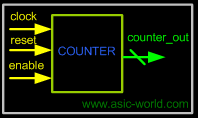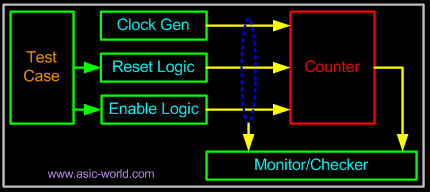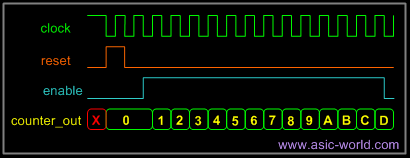|
|
| |
|

|
|
|
|
| |
|

|
| |
 |
Introduction
|
|
|
If you refer to any book on programming languages, it starts with an "Hello World" program; once you have written it, you can be sure that you can do something in that language  . . |
| |
|

|
|
|
Well I am also going to show how to write a "hello world" program, followed by a "counter" design, in Verilog. |
| |
|

|
| |
 |
Hello World Program
|
| |
|

|
|
|
1 //-----------------------------------------------------
2 // This is my first Verilog Program
3 // Design Name : hello_world
4 // File Name : hello_world.v
5 // Function : This program will print 'hello world'
6 // Coder : Deepak
7 //-----------------------------------------------------
8 module hello_world ;
9
10 initial begin
11 $display ("Hello World by Deepak");
12 #10 $finish;
13 end
14
15 endmodule // End of Module hello_world
You could download file hello_world.v here
|
| |
|

|
|
|
Words in green are comments, blue are reserved words. Any program in Verilog starts with reserved word 'module' <module_name>. In the above example line 8 contains module hello_world. (Note: We can have compiler pre-processor statements like `include', `define' before module declaration) |
| |
|

|
|
|
Line 10 contains the initial block: this block gets executed only once after the simulation starts, at time=0 (0ns). This block contains two statements which are enclosed within begin, at line 10, and end, at line 13. In Verilog, if you have multiple lines within a block, you need to use begin and end. Module ends with 'endmodule' reserved word, in this case at line 15. |
| |
|

|
| |
 |
Hello World Program Output
|
| |
|

|
|
|
Hello World by Deepak
|
| |
|

|
|
|
|
| |
|

|
| |
 |
Counter Design Block
|
| |
|

|
|
|
 |
| |
|

|
| |
 |
Counter Design Specs
|
| |
|

|
|
|
- 4-bit synchronous up counter.
- active high, synchronous reset.
- Active high enable.
|
| |
|

|
| |
 |
Counter Design
|
| |
|

|
|
|
1 //-----------------------------------------------------
2 // This is my second Verilog Design
3 // Design Name : first_counter
4 // File Name : first_counter.v
5 // Function : This is a 4 bit up-counter with
6 // Synchronous active high reset and
7 // with active high enable signal
8 //-----------------------------------------------------
9 module first_counter (
10 clock , // Clock input of the design
11 reset , // active high, synchronous Reset input
12 enable , // Active high enable signal for counter
13 counter_out // 4 bit vector output of the counter
14 ); // End of port list
15 //-------------Input Ports-----------------------------
16 input clock ;
17 input reset ;
18 input enable ;
19 //-------------Output Ports----------------------------
20 output [3:0] counter_out ;
21 //-------------Input ports Data Type-------------------
22 // By rule all the input ports should be wires
23 wire clock ;
24 wire reset ;
25 wire enable ;
26 //-------------Output Ports Data Type------------------
27 // Output port can be a storage element (reg) or a wire
28 reg [3:0] counter_out ;
29
30 //------------Code Starts Here-------------------------
31 // Since this counter is a positive edge trigged one,
32 // We trigger the below block with respect to positive
33 // edge of the clock.
34 always @ (posedge clock)
35 begin : COUNTER // Block Name
36 // At every rising edge of clock we check if reset is active
37 // If active, we load the counter output with 4'b0000
38 if (reset == 1'b1) begin
39 counter_out <= #1 4'b0000;
40 end
41 // If enable is active, then we increment the counter
42 else if (enable == 1'b1) begin
43 counter_out <= #1 counter_out + 1;
44 end
45 end // End of Block COUNTER
46
47 endmodule // End of Module counter
You could download file first_counter.v here
|
| |
|

|
| |
 |
Counter Test Bench
|
|
|
Any digital circuit, no matter how complex, needs to be tested. For the counter logic, we need to provide clock and reset logic. Once the counter is out of reset, we toggle the enable input to the counter, and check the waveform to see if the counter is counting correctly. This is done in Verilog. |
| |
|

|
|
|
 |
| |
|

|
|
|
The counter testbench consists of clock generator, reset control, enable control and monitor/checker logic. Below is the simple code of testbench without the monitor/checker logic. |
| |
|

|
|
|
1 `include "first_counter.v"
2 module first_counter_tb();
3 // Declare inputs as regs and outputs as wires
4 reg clock, reset, enable;
5 wire [3:0] counter_out;
6
7 // Initialize all variables
8 initial begin
9 $display ("time\t clk reset enable counter");
10 $monitor ("%g\t %b %b %b %b",
11 $time, clock, reset, enable, counter_out);
12 clock = 1; // initial value of clock
13 reset = 0; // initial value of reset
14 enable = 0; // initial value of enable
15 #5 reset = 1; // Assert the reset
16 #10 reset = 0; // De-assert the reset
17 #10 enable = 1; // Assert enable
18 #100 enable = 0; // De-assert enable
19 #5 $finish; // Terminate simulation
20 end
21
22 // Clock generator
23 always begin
24 #5 clock = ~clock; // Toggle clock every 5 ticks
25 end
26
27 // Connect DUT to test bench
28 first_counter U_counter (
29 clock,
30 reset,
31 enable,
32 counter_out
33 );
34
35 endmodule
You could download file first_counter_tb.v here
|
| |
|

|
|
|
time clk reset enable counter
0 1 0 0 xxxx
5 0 1 0 xxxx
10 1 1 0 xxxx
11 1 1 0 0000
15 0 0 0 0000
20 1 0 0 0000
25 0 0 1 0000
30 1 0 1 0000
31 1 0 1 0001
35 0 0 1 0001
40 1 0 1 0001
41 1 0 1 0010
45 0 0 1 0010
50 1 0 1 0010
51 1 0 1 0011
55 0 0 1 0011
60 1 0 1 0011
61 1 0 1 0100
65 0 0 1 0100
70 1 0 1 0100
71 1 0 1 0101
75 0 0 1 0101
80 1 0 1 0101
81 1 0 1 0110
85 0 0 1 0110
90 1 0 1 0110
91 1 0 1 0111
95 0 0 1 0111
100 1 0 1 0111
101 1 0 1 1000
105 0 0 1 1000
110 1 0 1 1000
111 1 0 1 1001
115 0 0 1 1001
120 1 0 1 1001
121 1 0 1 1010
125 0 0 0 1010
|
| |
|

|
| |
 |
Counter Waveform
|
| |
|

|
|
|
 |
| |
|

|
| |
|

|
| |
|

|
|
|
|
| |
|

|
|
|
|

|

|

|
|

|
|
Copyright © 1998-2025 |
Deepak Kumar Tala - All rights reserved |
|
Do you have any Comment? mail me at:deepak@asic-world.com
|
|